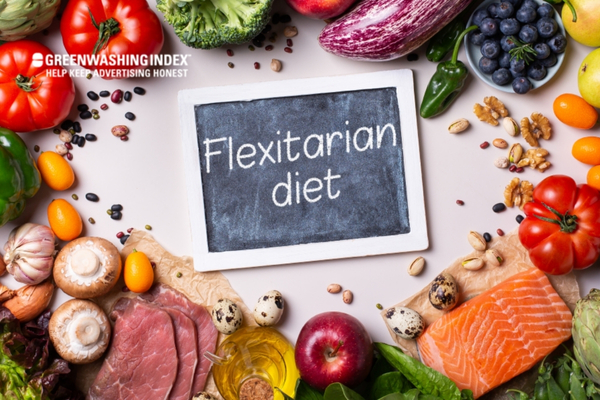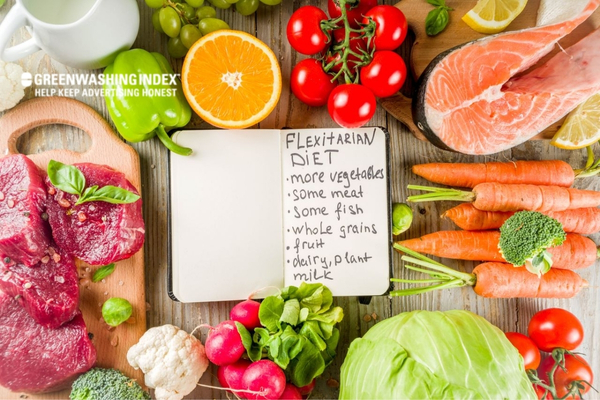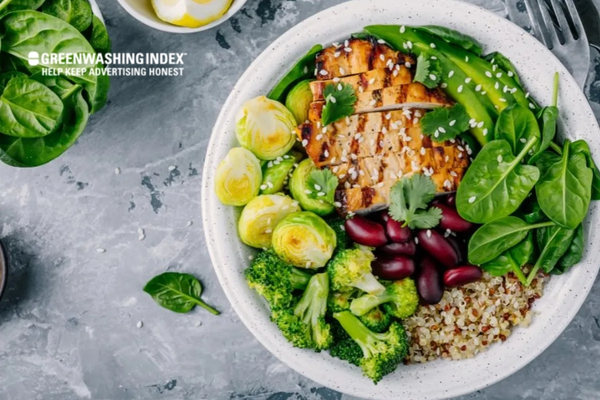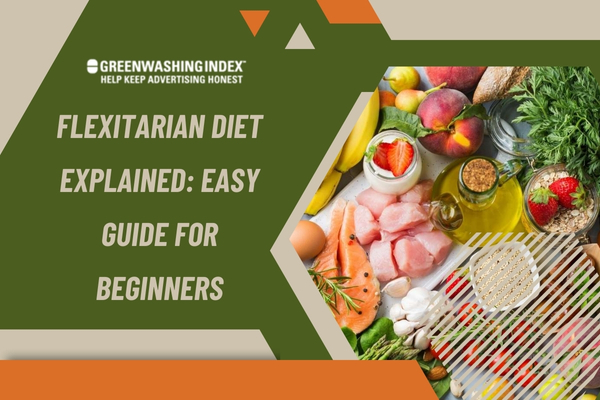Ever heard of a Flexitarian Diet? It’s the new buzz, and trust me, it could be what you’ve been looking for to spice up your meals and love life with plants! Imagine eating your favorite steak with a side of nutrient-rich veggies.
Doesn’t that sound like having the best of both worlds? That’s exactly what being flexitarian is all about – flexibility. So, if you’re intrigued by the freedom to enjoy meat while primarily indulging in vegetarian goodness, keep reading!
The simple answer to “What is a Flexitarian Diet?” is that it’s a smart way to eat healthier without giving up meat entirely. It’s about adding more plant-based foods to your diet and enjoying meat occasionally.
When you go flexitarian, you’re not just helping your body but also doing Mother Nature a solid since plant-centric diets are kinder to our planet. It makes healthy eating seem less like a chore and more like an exciting food adventure.
What You’ll Learn Right Here:
- Unwrap the basics of starting flexibly
- Discover tasty plant-based swaps for meat
- Boost your health while enjoying bite-sized changes
- Find out how this diet can be gentle on Earth
What is a Flexitarian Diet?
To understand the Flexitarian Diet, think of it as a style of eating that’s kind of like being vegetarian but with more flexibility.

Imagine eating lots of vegetables, fruits, whole grains, and plant proteins like beans and lentils. But, unlike a strict vegetarian diet where there is no meat at all, on a Flexitarian Diet, you can still enjoy meat occasionally. It’s about reducing the amount of meat without cutting it out entirely.
Here are the main points to easily grasp what makes up the Flexitarian Diet:
- Mainly Plant-Based: The focus is mostly on plants for nutrition.
- Flexible Meat Consumption: You’re not saying goodbye to meat forever. Instead, you have it less often and in smaller amounts.
- No Hard Rules: This diet doesn’t have strict rules or foods that are forbidden.
- Wholesome Foods: It encourages whole foods over processed ones.
The reason why people go for this diet over others could be because:
- It’s less restrictive than vegetarian or vegan diets.
- Allows for occasional indulgences, making it easier to stick with.
- It can be adapted to fit personal health needs or ethical concerns about animal products.
The Origin of the Flexitarian Movement
The idea behind being flexitarian isn’t entirely new—in fact, it has quite an interesting history!
It began gaining momentum as more people started looking for healthier ways to eat that also considered environmental impact and animal welfare but didn’t want to fully commit to becoming vegetarians or vegans.
Here’s how it unfolded:
- Initially sourced in books: A registered dietitian named Dawn Jackson Blatner wrote “The Flexitarian Diet,” which helped put this style of eating into words.
Looking back at its journey shows us that:
- Interest grew as individuals aimed for a balance between health benefits & ecological responsibility while still enjoying their favorite foods occasionally.
- It struck a chord, especially among those who wanted fewer restrictions on their dietary choices.
So essentially, flexitarians were seeking moderation; they loved their veggies but would also cherish a good steak now and then—all within limits that felt comfortable for their way of living while aligning with bigger-picture issues like sustainability.
And that’s your easy guide to understanding what exactly a Flexitarian Diet means — an adaptable way to eat focusing mainly on plant-based food without swearing off meat altogether!
Also Read: Old Electronics Disposal: Ultimate Recycling Tips Guide
Health Benefits of Adopting a Flexitarian Lifestyle
The flexitarian diet is about adding more plant foods and cutting back on meat without totally giving it up. I want to share why this can be good for your health.

Nutritional Advantages
When I started eating more like a flexitarian, I felt my body getting what it needed to stay healthy. Here’s what happens:
- More Veggies: Eating more plants means you get lots of vitamins.
- Variety is Key: Mixing different foods gives you a wide range of nutrients.
- Balance: This diet has meat, too, but in small parts. You still get protein from meat and plants.
- Fiber Up: Plants have fiber that helps your tummy work right.
- Keeping Fit: With all the veggies and whole foods, it’s easier to keep a healthy weight.
By eating this way, I get carbs for energy, protein for strong muscles, fats that are good for me, and lots of things that protect my cells, like vitamins and minerals.
Reducing Disease Risk
Research shows a flexitarian way of eating might help lower the risk of illnesses. It goes like this:
- Heart Health: Eating less red meat lowers the chance of heart problems.
- Sugar Check: A balanced diet with lots of plants could help avoid diabetes.
- Pressure Down: This diet also might help keep blood pressure in check because you eat less salt from processed meats.
Turning down meat sometimes means less saturated fat, which is better for your arteries. But remember – every person’s body works differently!
In short:
Eating as a ‘flexitarian’ helps me feel strong and avoid some diseases by making sure my meals are full of variety – both veggies and some meat. It feels good knowing I’m putting so much goodness on my plate!
Starting a new diet can feel a bit tricky, but when you choose to go for something flexible like the Flexitarian Diet, it can be an exciting adventure! Here’s my guide on how to step into this world of balance and plant-forward eating.
Also Read: Master Smell-Free Apartment Composting: An Ultimate Guide
How to Start Your Journey as a Flexitarian?
Have you ever heard of the term flexitarian diet? If this is new to you, don’t worry. I’m here to guide you through what it means and how to start your journey.

The flexitarian diet is a mix of two words: flexible and vegetarian. This diet style encourages eating more plant-based meals without giving up meat entirely. It’s about adding more veggies, grains, and legumes while scaling back on meat consumption but not eliminating it completely.
Simple Steps to Becoming Flexitarian
- Understand What It Means: Before anything else, know that the Flexitarian Diet means you’re choosing more plant-based foods while still enjoying meat once in a while. It’s about fewer rules and more freedom!
- Start Small: You don’t have to change everything at once. Begin by picking one meal a day or even one day a week where you’ll go meatless.
- Stock Your Kitchen with Veggies: Fill your fridge and pantry with plenty of fruits, vegetables, whole grains, nuts, and seeds. These will be your staples!
- Explore Plant-Based Protein Sources: Find out about proteins from plants like beans, lentils, tofu, and tempeh – they’re going to be key in your meals.
- Get Creative with Recipes: Have fun trying new recipes that celebrate veggies as the main event on your plate.
- Learn As You Go: There’s no need for perfection; learning what works for you is part of the journey!
Balancing Meat Consumption with Plant-Based Alternatives
Finding the sweet spot between meat and veggies depends on personal goals and preferences, but here are ways I make sure my plate is balanced:
- Go Gradual:
- Start by reducing meat portions in your meals rather than cutting them out entirely.
- Swap some of the meat for mushrooms or legumes – they add a “meaty” texture without the actual meat.
- Mix It Up:
- Try using half plant-based protein and half animal protein in dishes like chili or stir-fry.
- This way, you’ll slowly shift towards less meat over time without it feeling like a huge change.
- Pay Attention to Your Body:
- Listen closely to how these changes affect you – more energy? Better digestion? Every sign is important.
- Keep Checking In:
- Regularly assess how this balance works for your life and make tweaks if needed – there’s no strict rulebook here.
Just remember: stepping into flexitarian eating is all about small steps leading to big changes! Enjoy trying new things while listening closely to what feels right for you along this tasty journey!
Meal Planning for Aspiring Flexitarians
When I started my journey towards a Flexitarian Diet, meal planning was the key to making it work. It’s all about balance and giving room for both plant-based foods and occasional meat.
Essential Foods on the Flexitarian Menu
In my kitchen, there are a few staple foods that I swear by. These essentials help me keep my meals balanced between vegetarian and non-vegetarian choices. Here is a list of what you’d typically find in a flexitarian’s pantry:
- Vegetables: A colorful variety – think leafy greens, sweet potatoes, bell peppers.
- Fruits: Seasonal fruits are best; they taste great and are packed with nutrients.
- Whole Grains: Quinoa, brown rice, oats – they’re full of fiber that keeps me full longer.
- Legumes: Beans, lentils, and chickpeas are amazing protein sources.
- Nuts and Seeds: Almonds, flax seeds, or chia seeds for that crunch and omega-3s.
It’s not just about what I eat; it’s also about how these foods can be used in different ways to make meals interesting.
Crafting Diverse and Delicious Meals
Creating a diverse meal plan is like painting; you need different colors—or, in this case, flavors—to make it stand out:
- Start with a base like quinoa or brown rice
- Add color with a variety of veggies
- Choose lean protein; plant-based like lentils or occasional chicken
- Mix in nuts for extra texture
- Dress it up with sauces or herbs for flavor without the fat
Here’s an example of how I build my menu:
Breakfast:
I might have oats with almond milk topped off with fresh berries and nuts.
Lunch:
A big salad loaded with greens, chickpeas, or perhaps grilled fish if I’m having meat that day.
Dinner:
Stir-fry could be on the menu, mixing plenty of veggies tossed over quinoa or mixed into whole grain pasta.
Each meal is crafted to offer variety not just in taste but also nutrition – keeping things exciting while sticking to the Flexitarian way!
Challenges and Considerations on the Path to Flexible Vegetarianism
Adopting a new eating style like the Flexitarian Diet often comes with its fair share of hurdles. For those moving towards this flexible form of vegetarianism, let me share some of the common struggles you might encounter along the way.

Common Struggles When Transitioning
When I first dipped my toes into the world of flexitarian eating, I hit a few bumps on the road. Maybe they’ll sound familiar to you, too:
- Finding Balance: One main challenge is hitting that sweet spot where you’re not over-consuming meat or feeling deprived. It’s about balance.
- Meal Planning: Suddenly, you need to plan differently, especially when your go-to meals were meat-heavy before.
- Social Settings: Eating out or at a friend’s house can be tough when most dishes have meat, and there aren’t many veggie options around.
- Protein Sources: People often wonder if they’re getting enough protein from plant-based sources.
- New Cooking Skills: You might need to learn how to cook new foods, which takes time and effort.
- Becoming Overwhelmed by Choices: Or, inversely, feeling stuck in a rut with limited food choices can be real head-scratchers!
Dietary Tips for Long-Term Success
So you’ve decided to follow a Flexitarian Diet long-term; that’s wonderful! Here are some tips that could help maintain variety and keep things enjoyable:
- Mix Up Your Meals:
- Experiment with international cuisines—they’re full of veggie-rich dishes.
- Try one new fruit or vegetable each week.
- Use herbs and spices—these can transform any meal from okay to outstanding!
- Smart Swaps:
- Swap beans or lentils in a place where ground meat would usually take center stage—like in tacos or spaghetti sauce.
- Cauliflower makes for an amazing stand-in—think cauliflower steak or rice!
- Nuts and seeds can add crispiness as toppings instead of bacon bits.
- Learn Along The Way:
- Picking up cooking books or watching online tutorials will broaden your culinary skills.
- The more skills you have at making tasty veggie meals, the more likely it is you’ll stick with it long term.
- Enjoy The Experiment:
- See this as a chance to get creative with what’s in your fridge.
- Stay Open-minded:
- If one week doesn’t go according to plan, it’s not failure—it’s learning!
- Support System:
- Connect with others who are also eating more plant-based meals—you’re not alone here!
Remember this: lasting change is usually gradual change, so take small steps forward, and don’t rush it! This way, you’re more likely to enjoy your flexitarian journey rather than feel bogged down by pressure or stress over it!
Social Impact & Sustainability of Being a Part-Time Vegetarian
When I think about the social impact and sustainability of being a part-time vegetarian, also known as following a Flexitarian Diet, it’s clear that there’s more to it than just personal health benefits. This way of eating can actually create positive changes for our planet.
Ecological Footprint Reduction
Let me tell you how cutting back on meat by following the Flexitarian Diet can do wonders for the environment. It’s all about reducing my ecological footprint – that is, the mark I leave on Earth through my daily activities and choices.
First off, eating less meat means fewer animals have to be raised for food. You might know raising livestock like cows, pigs, and chickens takes up a lot of space and resources.
These animals need water, food, and land to live on. Plus, they produce waste, which can harm the land and water around them if not managed properly.
By choosing more plant-based meals, I’m helping reduce the demand for these resources. It’s simpler than it sounds – if we all eat just a bit less meat, fewer animals are needed to feed us. This means we save vast amounts of water and lower the strain on our soil.
Furthermore, plants usually need less space than animals do. So as more people go flexitarian, we could use some of that farmland for other stuff like forests or perhaps parks!
Plants are also great because they help clean our air by absorbing carbon dioxide – you know, that gas that contributes to global warming.
Another point is about greenhouse gases: Animals farmed for food produce methane – this is another gas causing climate change – but plants don’t give off methane like that.
So, by eating mostly veggies with just occasional meat dishes thrown in there now and then (as per the Flexitarian Diet), I’m doing my bit to cut down on harmful emissions going into our atmosphere!
And let’s not forget energy consumption: It takes more energy to produce animal-based foods compared to plant-based ones due to all the work involved in raising livestock (like providing heat and running equipment).
So, through this diet choice alone – being flexible about going meatless here and there – I help conserve energy, too!
Imagine how big an impact we could make if everyone did their part: Eating greener for healthier bodies and contributing toward a healthier planet – now, isn’t that something worth chewing over?
Conclusion
In navigating the many options for healthier eating, the Flexitarian Diet emerges as a standout choice because of its flexibility and balance. This approach to eating encourages a mostly plant-based diet while allowing room for meat and other animal products in moderation.
As someone considering such a lifestyle change, embracing the flexitarian principles offers a way to enjoy diverse foods, contribute positively to the environment, and ultimately live a healthier life without feeling too restricted.
The appeal of the Flexitarian Diet lies in its non-rigidity—it adapts to personal needs and preferences. It’s about making intentional choices toward better health and sustainability rather than following strict rules.



